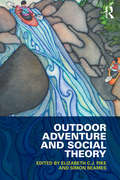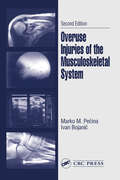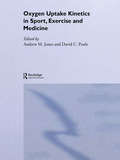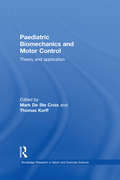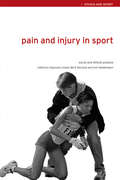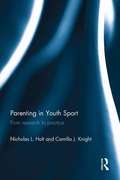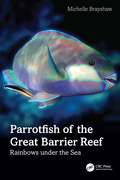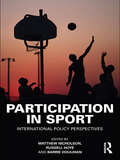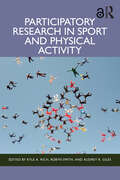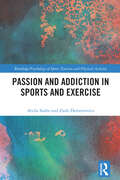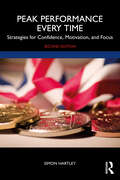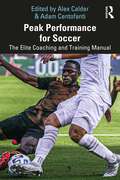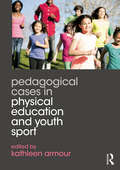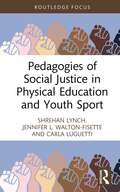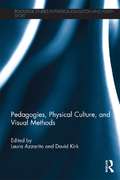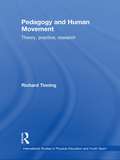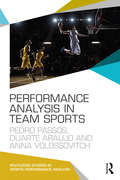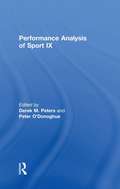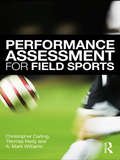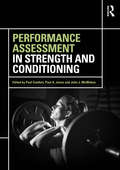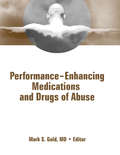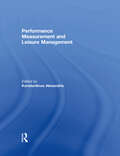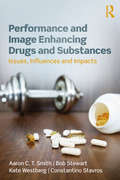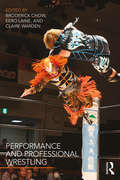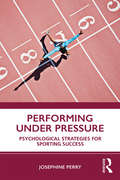- Table View
- List View
Outdoor Adventure and Social Theory
by Simon Beames Elizabeth C.J. PikeAdventure and outdoor sports - from rock climbing to freestyle kayaking – are a modern social phenomenon that can tell us much about the relationship between sport, culture and contemporary society. In this engaging new introductory text, adventure sports are used to illustrate key concepts in social theory and to demonstrate why an understanding of social theory is essential for any student taking a course in sport, adventure, or outdoor education. Each chapter in the book introduces a key ‘classical’ or modern social theorist, including Marx, Durkheim, Weber and Elias, or a universal topic or issue in social theory, such as sustainability, commodification or identity. Within each of those chapters the theorist or topic is brought to life through case studies of adventurous activities and lived experiences, helping the reader to connect their own sporting and adventurous interests with the frameworks we use to understand wider culture and society. Concise and full of cutting-edge contemporary examples, Outdoor Adventure and Social Theory is the perfect companion for any module on the sociology of sport, adventure or outdoor recreation.
Overuse Injuries of the Musculoskeletal System
by Marko M. Pecina Ivan BojanicOveruse injuries of the musculoskeletal system are common occurrences. Yet most existing volumes on cumulative trauma disorders deal with the subject from an ergonomic and occupational therapy standpoint, and do not provide the all-encompassing synopsis that physicians demand.Overuse Injuries of the Musculoskeletal System, Second Edition, answers t
Oxygen Uptake Kinetics in Sport, Exercise and Medicine
by Andrew M. Jones David C. PooleDespite its crucial importance, scientists interested in the limitations of human physical performance have only just started to give the field of oxygen uptake kinetics the attention it deserves. Understanding the principal determinant of the oxygen uptake kinetics is fundamental to improving human performance or the quality of life. This book provides a detailed overview of the current state of knowledge of this emerging field of study, and features: * an introduction to oxygen uptake kinetics and historical development of the discipline * measurement and analysis of oxygen uptake kinetics* control of and limitations to oxygen uptake kinetics* applications of oxygen uptake kinetics in a range of human populations. Oxygen Uptake Kinetics in Sport, Health and Medicine is richly illustrated and structured to enable easy access of information and represents an invaluable resource for students and researchers in exercise physiology, as well as for respiratory physiologists and pulmonary clinicians.
Paediatric Biomechanics and Motor Control: Theory and Application (Routledge Research in Sport and Exercise Science)
by Mark De Ste Croix Thomas KorffPaediatric Biomechanics and Motor Control brings together the very latest developmental research using biomechanical measurement and analysis techniques and is the first book to focus on biomechanical aspects of child development. The book is divided into four main sections – the biological changes in children; developmental changes in muscular force production; developmental changes in the biomechanics of postural control and fundamental motor skills and finally the applications of research into paediatric biomechanics and motor control in selected clinical populations. Written by a team of leading experts in paediatric exercise science, biomechanics and motor control from the UK, the US, Australia and Europe, the book is designed to highlight the key implications of this work for scientists, educators and clinicians. Each chapter is preceded by a short overview of the relevant theoretical concepts and concludes with a summary of the practical and clinical applications in relation to the existing literature on the topic. This book is important reading for any sport or exercise scientist, health scientist, physical therapist, sports coach or clinician with an interest in child development or health.
Pain and Injury in Sport: Social and Ethical Analysis (Ethics and Sport)
by Ivan Waddington Sigmund Loland Berit SkirstadFor elite athletes, pain and injury are normal. In a challenge to the orthodox medical model, this book makes it clear that pain and injury cannot be understood in terms of physiology alone, and examines the influence of social and cultural processes on how athletes experience pain and injury. It raises a series of key social and ethical questions about the culture of 'playing hurt', the role of coaches and medical staff, the deliberate infliction of pain in sport, and the use of drugs. This book begins by providing three different perspectives on the topic of pain and injury in sport, and goes on to discuss: * pain, injury and performance * the deliberate infliction of pain and injury * the management of pain and injury * the meaning of pain and injury.
Parenting in Youth Sport: From Research to Practice
by Camilla J. Knight Nicholas L. HoltBeing the parent of a young athlete is a complex and challenging endeavour. Parents play a pivotal role in the development of young people in reaching their full potential in sport – indeed, the psychological and practical support of parents can be as vital to young athletes as the appropriate coaching and facilities. This book brings together current research into the impact of parenting in youth sport and examines the relationships between athletes, coaches and parents, whilst also discussing topics such as parenting styles, behaviour at competition and talent development. This book not only outlines the theories of parenting in youth sport, but also utilises research and examples from several countries, including the UK, US, Canada, and Australia. It has a research-to-practice theme and includes numerous suggestions for research projects (and getting research published). Parenting in Youth Sport is an essential text for students, lecturers and practitioners with an interest in youth sport, sport psychology or sport development.
Parrotfish of the Great Barrier Reef: Rainbows under the Sea
by Michelle BrayshawThe array of colours found on the Scarini tribe (family: Labridae), commonly known as the Parrotfish, is truly astounding and is showcased to breathtaking effect in this book. Photographer and artist Michelle Brayshaw reveals the array of colour changes which these fish display through ontological (slow) and physiological (fast) processes. The obvious differences occur in the three phases of their lives, but it is the subtle changes in colour that can be the most bizarre, occurring while feeding, mating, courting, cleaning, camouflaging themselves to their backgrounds or the fish around them, experiencing mood swings, fighting, playing and, most excitingly of all, when they are transitioning from female to male. This feat is not unique to the Parrotfish, but no other animals do it with such glamour and colour.Through hundreds of hours of observational research, this book highlights the light play and physiological and ontological colour changes of the Scarini found on the Great Barrier Reef in stunning photographic accuracy. It also includes comprehensive information about why Parrotfish are so important for the health and resilience of the reef,f instilling in the reader a deeper sense of the treasures found there and reminding us of the interconnected nature of our existence.
Participation in Sport: International Policy Perspectives
by Matthew NicholsonAlthough there is growing interest from governments in participation levels in sport, the extent to which governments actively promote ‘sport for all’ and their motives for doing so vary greatly. This is the first book to examine the sport participation policies of national governments across the world and to offer a comparative analysis of the motives for, and successes and failures of those policies. Organized around a series of sixteen national case studies, including the UK, the US, Australia, China and India, the book enables students and practitioners to compare and contrast the development, implementation and impact of sport participation policies throughout the world. An introductory chapter provides a framework for understanding and interpreting those case studies and each chapter then addresses the following key themes: national structures for sport national sporting cultures participation levels in organized sport the nature and extent of government intervention implementation of governmental policy the impact of government policy. With contributions from many of the world’s leading experts on sport policy and sport development, this book is essential reading for anybody with an interest in the role of governments in relation to supporting and regulating their citizens’ involvement in sport.
Participatory Research in Sport and Physical Activity (Qualitative Research in Sport and Physical Activity)
by Robyn Smith Kyle A. Rich Audrey R. GilesThis is the first book to focus on participatory research in the context of sport and physical activity. It explores the transformative potential of participatory research methods and provides an introduction to the practicalities of doing participatory research in sport and physical activity.The book is structured around phases of the research process, covering research design, data collection, data analysis, and knowledge mobilization and translation. Chapters cover research design topics such as building research partnerships, reflexivity and ethical issues; methods such as social photo-elicitation, go-along interviews, and biographical mapping; analytical approaches such as collective memory work and collaborative analysis; and knowledge mobilization and translation topics such as podcasting, digital tools, and peer review. Every chapter includes a review of key developments, a guide to how that approach can be employed, an example from the author’s own work, and critical reflections on how that approach can shape future research and have an impact on public discourse.This book is an invaluable resource for students and researchers working in sport studies, the sociology of sport, sport and exercise psychology, sport management and policy, and human movement and health studies more broadly. It will be particularly useful for those interested in diverse and inclusive approaches to qualitative research methodologies.
Passion and Addiction in Sports and Exercise (Routledge Psychology of Sport, Exercise and Physical Activity)
by Attila Szabo Zsolt DemetrovicsPassion and Addiction in Sports and Exercise is about the bright and dark aspects of sports and exercise behavior and revolves around two closely related yet distinct concepts. Passion is a joyful and healthy reflection of one’s enjoyment and dedication to an adopted sport or exercise. At the same time, exercise addiction is an obligatory and must-be-done training regimen. This book is the first to attempt to explain the significant differences between passion and addiction in sports and exercise. This book presents an overview of three dimensions of passion and offers a new frame to contextualize exercise addition. The work also addresses the misinterpretation of certain aspects of training (e.g., intensity, frequency, commitment) often related to addiction. After introducing the health benefits of exercise, the book looks at the passion for sports and exercise training and the transition into maladaptive practice. Then it presents definitions and theoretical models for exercise addiction. It then examines exercise addiction cases while also illustrating how excessive or high exercise volumes are beneficial instead of problematic. The last chapter offers a new approach for a better understanding of exercise addiction. Passion and Addiction in Sports and Exercise is helpful for students, researchers, and clinicians interested in sport and exercise psychology, athletic training, behavioral addictions, and physical
Peak Performance Every Time: Strategies for Confidence, Motivation, and Focus
by Simon HartleyMost people have good days…and not so good days. When they step back and ask what makes the difference, many conclude that it’s that stuff that happens between their ears. So, how do we engineer our mindset? How do we get our mental game right, so that we can perform at our best, consistently? Peak Performance Every Time provides readers with a detailed look into how to build the critical components of a great mental game. It will help them to hone their focus, control their confidence, master motivation and deliver their best ‘under pressure’. In short, it will help deliver peak performance, every time. The book provides a practical guide to performance psychology, based on approaches and methods that have been tried and tested in the demanding world of elite sport. In addition to applied practice, it provides real life examples and case studies from both elite sport and business, plus the underpinning theory and research. This book will be invaluable to anyone trying to reach their full potential, in particular athletes, coaches, managers and executives. It may also be of interest to sports psychology, management and business students.
Peak Performance for Soccer: The Elite Coaching and Training Manual
by Alex Calder Adam CentofantiIn this book, over 40 of the world’s leading practitioners working in elite soccer— over 6 continents—share advanced knowledge of the environment as well as a scientific understanding of the game and players. This book explores those traits at an intricate level through shared experiences of some of the best performance coaches working in elite soccer. The content in this book is derived from practical and evidence-based concepts that have been applied at the elite level. Uncovering the coaching strategies as well as contemporary issues in elite soccer, this comprehensive textbook illustrates what it takes to thrive as a performance coach at the top level. Collaborating with the industry leaders in soccer, the chapters address a myriad of topics such as: • the multiple roles and responsibilities; • youth development; • strength and conditioning application; • nutrition and recovery strategies; • tracking and monitoring fitness and fatigue; • powerful communication methods and staff cohesion; and • return to play and injury prevention strategies Peak Performance for Soccer is essential reading for all coaches and practitioners, at any level, who work in soccer. Alex Calder is the head of sports science with the Houston Dynamo, competing in Major League Soccer (MLS). He is an accredited level 3 elite coach with the Australian Strength and Conditioning Association (ASCA), as well as holding accreditations through the National Strength and Conditioning Association (NSCA) and Collegiate Strength and Conditioning Coaches Association (CSCCa). Adam Centofanti is currently the head of fitness for the Seattle Sounders FC, having previously served as the head of academy strength and conditioning for Houston Dynamo FC. Formally with Melbourne City FC, Adam held various roles with the club including conditioning coach/sports scientist in the academy sector as well as overseeing the women’s performance program, achieving multiple championships.
Pedagogical Cases in Physical Education and Youth Sport
by Kathleen ArmourPedagogical Cases in Physical Education and Youth Sport is a completely new kind of resource for students and practitioners working in physical education or youth sport. The book consists of 20 richly described cases of individual young learners, each written by a team of authors with diverse expertise from across the sport, exercise and movement sciences. These cases bring together knowledge from single sub-disciplines into new interdisciplinary knowledge to inform best practice in physical education, teaching and coaching in youth sport settings. At the heart of each case is an individual young person of a specified age and gender, with a range of physical, social and psychological characteristics. Drawing on current research, theory and empirical data from their own specialist discipline, each chapter author identifies the key factors they feel should be taken into account when attempting to teach or coach the young person described. These strands are then drawn together at the end of each chapter and linked to current research from the sport pedagogy literature, to highlight the implications for planning and evaluating teaching or coaching sessions. No other book offers such a rich, vivid and thought-provoking set of pedagogical tools for understanding and working with children and young people in sport. This is an essential resource for any student on a physical education, coaching, kinesiology or sport science course, and for any teacher, coach or instructor working in physical education or youth sport.
Pedagogies of Social Justice in Physical Education and Youth Sport (Routledge Focus on Sport Pedagogy)
by Shrehan Lynch Jennifer L. Walton-Fisette Carla LuguettiThis book offers an overview of contemporary debates in social justice and equity within Physical Education (PE) and Youth Sport (YS). It gives the reader clear direction on how to evaluate their current PE or YS program against current research and provides ideas for content, curriculum development, implementation, and pedagogical impact. The book addresses key contemporary issues including healthism, sexism, racism, classism, heterosexism, ableism and colonialism, and it highlights the importance of positionality and critical awareness on the part of the teacher, coach, or researcher. Presenting an array of case studies, practical examples, and thought-provoking questions, the book discusses equitable pedagogies and how they might be implemented, including in curriculum design and assessment. Concise, and avoiding academic jargon, this is an invaluable guide for pre-service and in-service teachers, teacher educators, coaches, and educators, helping them to ensure that all students and young people are included within the PE and YS settings for which they are responsible.
Pedagogies, Physical Culture, and Visual Methods (Routledge Studies in Physical Education and Youth Sport)
by David Kirk Laura AzzaritoTo understand and more creatively capture the social world, visual methods have increasingly become used by researchers in the social sciences and education. However, despite the rapid development of visual-based knowledge, and despite the obvious links between human movement and visual forms of understanding, visual research has been scarce in the fields of physical culture and physical education pedagogy. This groundbreaking book is the first to mark a "visual turn" in understanding and researching physical culture and pedagogies, offering innovative, image-based research that reveals key issues in the domains of sport, health, and physical education studies. Integrating visual research into physical culture and pedagogy studies, the book provides the reader with different ways of "seeing", looking at, and critically engaging with physical culture. Since human movement is increasingly created, established, and pedagogized beyond traditional educational sites such as schools, sport clubs, and fitness gyms, the book also explores the notion of visual pedagogy in wider physical culture, helping the reader to understand how visual-based technologies such as television, the internet, and mobile phones are central to people’s engagement with physical culture today. The book demonstrates how the visual creates dynamic pedagogical tools for revealing playful forms of embodiment, and offers the reader a range of visual methods, from researcher-produced photo analysis to participatory-centred visual approaches, that will enhance their own study of physical culture. Pedagogies, Physical Culture and Visual Methods is important reading for all advanced students and researchers with an interest in human movement, physical education, physical culture, sport studies, and research methods in education.
Pedagogy and Human Movement: Theory, Practice, Research (Routledge Studies in Physical Education and Youth Sport)
by Richard TinningAcross the full range of human movement studies and their many sub-disciplines, established institutional practices and forms of pedagogy are used to (re)produce valued knowledge about human movement. Pedagogy and Human Movement explores this pedagogy in detail to reveal its applications and meanings within individual fields. This unique book examines the epistemological assumptions underlying each of these pedagogical systems, and their successes and limitations as ways of (re)producing knowledge related to physical activity, the body, and health. It also considers how the pedagogical discourses and devices employed influence the ways of thinking, practice, dispositions and identities of those who work in the fields of sport, exercise and other human movement fields. With a scope that includes physical education, exercise and sports science, sports sociology and cultural studies, kinesiology, health promotion, human performance and dance, amongst other subjects, Pedagogy and Human Movement is the most comprehensive study of pedagogical cultures in human movement currently available. It is an invaluable resource for anybody with an interest in human movement studies.
Performance Analysis in Team Sports (Routledge Studies in Sports Performance Analysis)
by Pedro Passos Duarte Araújo Anna VolossovitchFilling an important gap in performance analysis literature, this book introduces the key concepts and practical applications of performance analysis for team sports. It draws on cutting-edge research to examine individual and collective behaviours across an array of international team sports. Evidencing the close relationship between coaching and performance analysis, it promotes a better understanding of the crucial role of performance analysis in team sports for achieving successful results. This book not only presents a variety of different ways to analyse performance in team sports, but also demonstrates how scientific data can be used to enrich performance analysis. Part one delineates the main guidelines for research in performance analysis, discussing the characteristics of team sports, coaching processes, variables characterizing performance and methods for team member interaction analysis. Part two drills down into performance analysis across a range of team sports including soccer, basketball, handball, ice hockey, volleyball and rugby. Performance Analysis in Team Sports is an essential companion for any course or research project on sports performance analysis or sports coaching, and an invaluable reference for professional analysts.
Performance Analysis of Sport IX
by Peter O'Donoghue Derek PetersPerformance analysis techniques help coaches, athletes and sport science support officers to develop a better understanding of sport performance and therefore to devise more effective methods for improving that performance. Performance Analysis of Sport IX is the latest in a series of volumes that showcase the very latest scientific research into performance analysis, helping to bridge the gap between theory and practice in sport. Drawing on data from a wide variety of sports, the book covers every key topic and sub-discipline in performance analysis, including: analysis of technique technical effectiveness tactical evaluation studying patterns of play motor learning and feedback work rate and physical demands performance analysis technology analysis of elite athletes and teams effectiveness of performance analysis support observational analysis of injury risk analysis of referees Effective performance analysis is now an essential component of the high performance strategy of any elite sport team or individual athlete. This book is therefore essential reading for any advanced student or researcher working in performance analysis, and invaluable reading for any sport science support officer, coach or athletic trainer looking for ways to improve their work with athletes
Performance Assessment for Field Sports
by Tom Reilly Christopher Carling A. Mark WilliamsWhat are the most effective tools, techniques and technologies available to coaches and sport scientists in the assessment of player and team performance? This is the first book dedicated to the assessment of performance in field sports such as soccer, rugby, hockey and lacrosse. It provides detailed and clear information about the laboratory and field-based methods that can be used to evaluate improvements in individual and team performance, from basic physiological assessment to the use of video and information technologies. Standing at the interface between sport sciences and sport coaching, the book examines a wide range of performance criteria, including: physiology strength, conditioning and fitness decision-making coordination and motor skills sport specific skills team play. Integrating cutting-edge theory, research and technology with best practice in applied sport science, this book is important reading for all students of sport sciences, kinesiology, human movement science, sports performance, or sports coaching. Christopher Carling is Head of Sports Science at Lille Football Club. Thomas Reilly is Director of the Research Institute for Sport and Exercise Sciences at Liverpool John Moores University. He is President of the World Commission of Science and Sports. A. Mark Williams is Professor of Motor Behaviour at the Research Institute for Sport and Exercise Sciences, Liverpool John Moores University.
Performance Assessment in Strength and Conditioning
by Paul Comfort Paul A. Jones John J. McMahonIt is an essential skill for any strength and conditioning coach to be able to reliably assess the physical performance of their athletes and communicate the results and their implications to performers and coaches, alike. Performance Assessment in Strength and Conditioning is the first textbook to clearly and coherently suggest the most appropriate and reliable methods for assessing and monitoring athletes’ performance, as well as including detailed sections on testing considerations and the interpretation and application of results. The book explores the full range of considerations required to reliably assess performance, including questions of ethics and safety, reliability and validity, and standardised testing, before going on to recommend (through a comparison of field- and laboratory-based techniques) the optimal methods for testing all aspects of physical performance, including: injury risk jump performance sprint performance change of direction and agility strength power aerobic performance body composition Closing with a section on interpreting, presenting and applying results to practice, and illustrated with real-life case study data throughout, Performance Assessment in Strength and Conditioning offers the most useful guide to monitoring athlete performance available. It is an essential text for upper-level strength and conditioning students and practitioners alike.
Performance Enhancing Medications and Drugs of Abuse
by Mark GoldPerformance Enhancing Medications and Drugs of Abuse explores various medications currently being abused by patients, from the drugs used for physical and cosmetic purposes by weekend warriors, professional athletes, and other at-risk populations, to the drugs used to enhance mood and memory.
Performance Measurement and Leisure Management
by Konstantinos AlexandrisThe issue of performance measurement in the leisure industry is increasingly important, from both theoretical (academic) and applied (practitioner) perspectives. Managers need accurate indications of how their organisations are performing, to inform their decisions. Policymakers need an evidence base for their decisions regarding public leisure services. Students and researchers in leisure management are increasingly turning their attention to the principles and evidence of performance measurement, as an aid to management decision-making.The chapters in this text each present a different case study of performance measurement. They cover a wide range of sectors in the leisure industry including public recreation centres, theme parks, play facilities, sport organisations, hospitality, and the Olympic Games. The evidence from these cases covers examples from three different continents and five different countries.All the chapters report empirical research and all the cases explore managerial implications. However, results are presented with clearly explained statistical analysis, which can be easily understood by a non-academic audience. The book will be useful for leisure management students, researchers and practitioners. The chapters provide both reviews of the relevant literature and propose new measurement models based on original data.This book was previously published as a special issue of Managing Leisure.
Performance and Image Enhancing Drugs and Substances: Issues, Influences and Impacts
by Bob Stewart Aaron Smith Constantino Stavros Kate WestbergIn the pursuit of more muscle, enhanced strength, sustained endurance and idealised physiques, an increasing number of elite athletes, recreational sport enthusiasts and body-conscious gym-users are turning to performance and image enhancing drugs and substances (PIEDS). In many instances, such use occurs with little regard for the health, social and economic consequences. This book presents a nuanced, evidence-based examination of PIEDS. It provides a classification of PIEDS types, physical impacts, rates of use, user profiles, legal and sporting status, and remedial program interventions, covering both elite and recreational use. It offers the perfect guide to assist students, government policy makers and sport managers in understanding the complex issues surrounding PIEDS consumption.
Performance and Professional Wrestling
by Claire Warden Broderick Chow Eero LainePerformance and Professional Wrestling is the first edited volume to consider professional wrestling explicitly from the vantage point of theatre and performance studies. Moving beyond simply noting its performative qualities or reading it via other performance genres, this collection of essays offers a complete critical reassessment of the popular sport.Topics such as the suspension of disbelief, simulation, silence and speech, physical culture, and the performance of pain within the squared circle are explored in relation to professional wrestling, with work by both scholars and practitioners grouped into seven short sections: Audience Circulation Lucha Gender Queerness Bodies Race A significant re-reading of wrestling as a performing art, Performance and Professional Wrestling makes essential reading for scholars and students intrigued by this uniquely theatrical sport.
Performing Under Pressure: Psychological Strategies for Sporting Success
by Josephine PerryPerforming Under Pressure is an essential resource on improving sporting performance in high-pressure situations. Perry’s work guides coaches and athletes through nine key elements of the sporting mindset to help athletes to perform at the highest standards, even under the most pressurized of situations. This valuable read includes empirically-based advice on areas such as embracing competition; building confidence, concentration and focus; maintaining emotional control; learning from and coping with failure or injury; being braver; and being able to push harder. Perry also provides 64 strategies to support each sporting mindset, offering not just the evidence as to why they work but exactly how to implement them. This book uniquely offers those supporting athletes a toolkit of sport psychology strategies and interventions in a way that is evidence-based, accessible and engaging, whether you are starting out studying sport psychology, on a sports science course, or are a coach of many years' standing, for both elite and amateur athletes.
